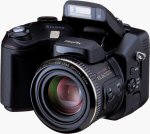 Full review posted for Fuji FinePix S20 Pro
Full review posted for Fuji FinePix S20 Pro
By
Dave Etchells
(Tuesday, April 27, 2004 - 14:11 EDT)
Fuji's "SR" sensor technology has generated controversy in the marketplace, as there's been some dispute by reviewers as to whether it actually delivers on its promises of increased dynamic range.
It turns out that much of the apparent problem can be traced to a lack of understanding of just how the SR technology works, and most particularly what scene characteristics trigger its application. In my review of the FinePix S20 Pro, I look in some detail at the SR technology in action, and compare results from one of my deliberate "torture test" scenes from the S20 Pro and a camera with a conventional CCD. The results are pretty unequivocal, there's clearly more highlight detail preserved by the SR sensor in the S20 Pro.
Along with the S20 Pro, Fujifilm has also released an updated version of their RAW file processing application, enabling users to choose for themselves how much of the "R" pixel data is incorporated into the final image. While this addresses some criticisms of the camera raised by others, I do still think that there's another level that Fujifilm could go to, to make the SR technology even more useful to photographers. I also address the issue of how many "megapixels" the S20 Pro's sensor has, hopefully clearing up some of the confusion between the "official" definition of megapixel by the JCIA trade group and how the sensors behave in actual practice.
... Oh right, the camera! - The S20 Pro has good color, and (obviously) good dynamic range, but its high minimum ISO rating of 200 means that even images shot under bright lighting will have high levels of noise. (It must be noted that the S20 Pro's noise level at ISO 200 is fairly comparable to that of other cameras in its class when operating at that ISO. It's just that all the competing models also allow you do drop down to ISO 100, 64, or even 50 to achieve lower noise levels, and the S20 Pro lacks that option.)
I also suspect that, while the S20 Pro's dynamic range capabilities are impressive, many potential users may be unwilling to accept the tradeoff in resolution that the technology demands. (Perhaps when we get to the point that there's are SR sensors available with a true 6 megapixel array, that tradeoff will seem less severe. - So I guess, stay tuned for Fujifilm's S3 Pro SLR whenever it hits the market.) One bright point - The S20 Pro does offer excellent camera control via its FireWire interface, so it should be attractive to people doing event photography or possible mass portraits, where close integration with a controlling computer would be a distinct advantage.
Overall, an interesting camera, read the review for all the details!
|